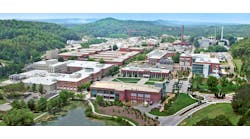At Data Center Frontier, design is one of the major themes we see shaping the industry. Our thesis: New markets will require new approaches to data center design, creating facilities that can operate with very different climate and energy profiles. This will require major innovation in the way data centers are designed, built and powered.
Over the past year, we’ve interviewed many of the industry’s leading thinkers on design, and developed case studies of how leading companies in our field are using design to differentiate themselves and target business opportunities.
Here’s a comprehensive guide to the State of Data Center Design in 2016:
Big-Picture Trends
The evolution of data center design can impact broad sectors of the industry, molding decisions on site location and construction spending. At Data Center Frontier we gather a spectrum of perspectives from data center professionals, seeking to separate genuine trends from one-off scenarios. Here’s our in-depth analysis of four of the trends shaping the business.
- Super-Sizing the Cloud Campus: Internet titans are concentrating massive amounts of computing power in regional cloud campuses housing multiple data centers. We bring you inside a Facebook data center campus to illustrate the pioneering concepts that are working for hyperscale providers.
- Right-Sizing for the Edge: Data Center Design in Secondary Markets: Modular design and lean construction methods are playing a major role as the data center industry expands in new places. As data moves to the edge of the network, data centers are being right-sized to fit the demands of these new markets.
- The Density Debate: Is Cooling Door Adoption a Sign of Coming Shift? Does an uptick in adoption of water-chilled cooling doors signal a trend towards higher rack densities in data centers? Colovore and LinkedIn are among those implementing rear-door cooling units.
- Data Centers Adapt as Tenants Seek Options on Power Redundancy: Several wholesale data center providers have unveiled plans to offer data halls with less backup power infrastructure than traditional data centers, which typically offer multiple levels of emergency power in the event of a utility grid outage.
Case Studies: Using Design to Target Growth Scenarios
One of the best ways to illustrate the power of a design concept is to explore its implementation at a single data center or company. At Data Center Frontier, we use the data center as a prism for telling the story of the industry and how it is growing and evolving.
These case studies provide a detailed discussion of how companies are using design to address opportunities in capacity management, modular deployment at scale, challenging environments, energy efficiency, extreme density and target opportunities in edge markets and cloud providers.
- Aligned Data Centers Seeks to Solve the Capacity Challenge: Aligned Data Centers hopes to bring cloud-style pricing and hyperscale-level efficiency into the multi-tenant data center sector. Its approach is focused on the supply chain and solving the data center capacity management challenge.
Modular data centers fill a portion of an IO data center. IO plans to add a second multi-story modular data center at its Phoenix campus. (Photo: IO)
- Modular Goes Multi-Story: IO Plans Huge Expansion in Phoenix: IO plans a huge expansion of its data center campus in Phoenix, where it will build a three-story modular data center, going vertical to optimize its use of space to house modules.
- Taking Tier IV to Thailand: A Modular Design for the Global Market: Data center design refinements developed at the Switch SUPERNAP cloud campus Las Vegas are yielding benefits as the company expands into new global markets, such as its latest SUPERNAP project near Bangkok, Thailand.
- Compass Targets the Cloud Market With New Data Center Design: Compass Datacenters recently unveiled a new design, providing flexibility for customers to build larger and denser data centers. Compass believes the design will help it win business among cloud computing providers.
- Equinix Updates its Data Center Design: Equinix will be using a new design for data center projects that come online in 2017, incorporating hot aisle containment and indirect evaporative cooling. The company says the new design will reduce energy and water use.
- EdgeConneX: Scaling Up the Lights Out Data Center: EdgeConneX is operating unmanned “lights out” data centers in 20 markets across the United States, marking the industry’s most ambitious use of automation to streamline data center operations.
A row of extra-tall 60U racks inside Intel’s new data center in Santa Clara. (Photo: Rich Miller)
- Intel Data Center Design Reaches New Heights of Efficiency: Intel is using extra-tall racks that pack more servers into the same space. The new 60U racks are central to a new Intel design that combines extreme density and energy efficiency, with a PUE of 1.06.
- Oracle’s Data Center Journey: The evolution of Oracle’s Utah Compute Facility (UCF) illustrates ongoing changes in technology and best practices, as well as Oracle’s emphasis on continuous refinement of data center design.
- Immersion Cooling At Scale: BitFury Pushes Density to 250kW Per Rack: BitFury will use immersion cooling to manage power densities of 250kW per enclosure. It’s the largest implementation yet of immersion cooling, which houses servers in enclosures filled with fluid, and pushes the boundaries of rack densities.
Data Center Frontier charts the future of data centers and cloud computing. We track the latest developments in data center design, providing updates on the innovations and best practices for creating energy efficient and sustainable data centers. For more, see our Data Center Design Channel.






